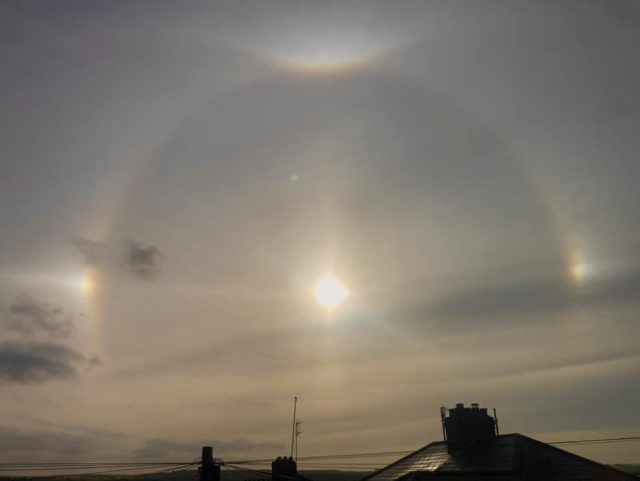The skies above Consett, Co. Durham recently showcased a mesmerizing spectacle that left onlookers in awe – a remarkable sighting of the Sun Halo. As the Sun beamed its radiant light, a captivating ring of luminosity encircled its brilliance. Have you had the fortune of witnessing this ethereal phenomenon and found yourself pondering its origins? In this article, we embark on an enchanting exploration of the world of Sun Halos and Sun Dogs, unravelling their mysteries and illuminating the scientific explanations that underpin these extraordinary optical displays.
Table of Contents
- What is a Sun Halo?
- How does a Sun Halo form?
- The role of ice crystals in Sun Halos
- Types of Sun Halos
- Sun Dogs: A close cousin of Sun Halos
- Sun Dogs and their formation
- The difference between Sun Halos and Sun Dogs
- FAQs about Sun Halos and Sun Dogs
1. What is a Sun Halo?
A Sun Halo, also known as a 22-degree halo, is a ring of light that encircles the Sun. It appears as a bright, circular band with a radius of approximately 22 degrees around the Sun, creating a breath-taking spectacle in the sky. The ring is usually white, but sometimes displays vibrant colours, such as reds and blues, on its inner edge.



2. How does a Sun Halo form?
Sun Halos are optical phenomena caused by the interaction of sunlight with ice crystals suspended in the Earth’s atmosphere. These crystals act as tiny prisms, refracting and reflecting sunlight to create the halo effect. When light enters a crystal, it bends, and upon exiting, it bends again. This refraction and subsequent reflection within the crystals result in the formation of the circular ring around the Sun.
3. The role of ice crystals in Sun Halos
The formation of Sun Halos heavily relies on the presence of ice crystals in the atmosphere. These crystals can take various forms, including hexagonal plates and columnar shapes, each contributing to the unique appearance of the halo. As sunlight passes through these crystals, it undergoes intricate interactions, leading to the dispersion of colours and the formation of the characteristic halo shape.
4. Types of Sun Halos
There are several types of Sun Halos, each displaying distinct features and variations. Some common types include:
- 22-degree Halo: The most frequently observed type, forming a circular ring at a radius of 22 degrees around the Sun.
- Circumhorizontal Arc: Often referred to as a “fire rainbow,” it appears as a colourful arc beneath the Sun, resulting from sunlight passing through horizontally oriented ice crystals.
- Circumscribed Halo: This rare and fascinating halo displays additional concentric rings around the 22-degree halo, creating a visually striking effect.
5. Sun Dogs: A close cousin of Sun Halos
Sun Dogs, also known as parhelia, are another captivating optical phenomenon that shares similarities with Sun Halos. These bright spots of light appear on either side of the Sun and often accompany Sun Halos, enhancing the celestial spectacle. Sun Dogs are created by the refraction and reflection of sunlight through hexagonal ice crystals in the atmosphere.
6. Sun Dogs and their formation
The formation of Sun Dogs is similar to that of Sun Halos, with sunlight interacting with ice crystals to produce this stunning effect. Sun Dogs are specifically caused by plate-shaped ice crystals that are oriented horizontally in the atmosphere. These crystals act as tiny prisms, bending and refracting sunlight to create the glowing spots of light on either side of the Sun.
7. The difference between Sun Halos and Sun Dogs
While Sun Halos and Sun Dogs share similarities in their formation and association with ice crystals, there are notable differences between the two phenomena. Sun Halos form a complete circle around the Sun, while Sun Dogs are distinct, bright spots of light appearing on either side of the Sun. Sun Dogs are often accompanied by a halo, adding to the overall spectacle.
8. FAQs about Sun Halos and Sun Dogs
A: While Sun Halos and Sun Dogs are not everyday occurrences, they are not exceptionally rare either. The frequency of their appearance depends on the atmospheric conditions and the prevalence of ice crystals.
A: Sun Halos have fascinated cultures throughout history, often associated with mystical or spiritual meanings. In folklore, they have been interpreted as omens of change or impending weather events.
A: Sun Halos themselves are not harmful to observe. However, it is important to avoid looking directly at the Sun, as its intense rays can damage the eyes. Observing Sun Halos indirectly, such as through sunglasses or using proper solar filters, ensures safe viewing.
A: Sun Halos are most commonly observed when there are high, thin clouds containing ice crystals. The presence of these clouds allows sunlight to interact with the crystals, creating the halo effect.
A: Sun Halos are solely optical phenomena that occur when sunlight interacts with ice crystals. Therefore, they cannot be observed during the night when the Sun is not visible.
A: Yes, Sun Halos can be captured beautifully through photography. Using a camera with manual settings and a wide-angle lens can help capture the entire halo and its vibrant colours.
The ethereal beauty of Sun Halos and Sun Dogs has captivated sky gazers for centuries. The recent sighting of a Sun Halo in Consett have left locals in awe, their spirits lifted by the enchanting display. These mesmerizing optical phenomena, born from the delicate dance between sunlight and ice crystals, grace the heavens with their stunning presence. Whether you have been fortunate enough to witness a Sun Halo firsthand in Consett’s skies or are eagerly awaiting your opportunity, delving into the scientific explanations behind these celestial wonders adds an extra layer of awe and appreciation. So, with eyes turned skyward, stay vigilant, for the next time you cast your gaze upward, you may be rewarded with a magical Sun Halo or its faithful companion, the illustrious Sun Dog.








